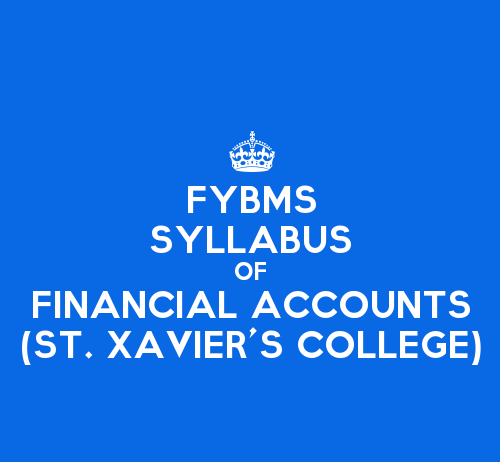Introduction to Financial Accounts is a subject in Semester 1 of FYBMS. Financial Accounts or Financial Accounting is a specialized branch of accounting that keeps track of the financial transactions of an organization. The purpose of financial accounting is to provide information that is useful for the stakeholders of the organization to assess the value of the company for themselves.
Introduction to Financial Accounts subject is introduced in FYBMS Sem 1 to familiarize the students with the basic accounting principles and techniques of preparing and presenting the accounts for user of accounting information.
The subject is covered in 60 lectures and has 4 main units.
Unit 1: 20 lectures:
1) Meaning and Scope of Accounting:
The topics covered in this chapter are:
Need, development and definition; Book-keeping and accounting; persons interested in accounting; disclosures; branches of accounting; objectives of accounting and principles of accounting.
2) Accounting Transactions:
The topics covered in this chapters are: Accounting cycle, journal, journal proper opening and closing entries, relationship between ledger and journal, rules regarding posting, trial balance, subsidiary books, bank reconciliation statement.
3) Accounting Standards:
AS 1 – Disclosure of accounting policies, meaning of accounting policies – purpose – different policies – areas of policies – disclosure of policies – disclosure of change in policies – simple illustrations.
AS 6 – Depreciation accounting: Meaning – Definitions – Importance – Factors – Useful life of a depreciable asset – Estimating useful life – Additions – Residual value – Methods – Disclosure of surplus – RBM/FIM – Simple illustrations
AS 9 – Revenue recognition: Meaning and scope – Transactions excluded- Sale of goods – Rendering of services – Effect f uncertainties – Disclosure – Simple illustrations
AS 10 – Accounting for fixed assets : Meaning – Definitions – Importance – Cost of fixed assets – Self constructed fixed assets – Non monetary consideration – Improvements, repairs, additions and extensions – Revaluation – Sale or retirement – Valuation of fixed assets in special cases – Special types of fixed assets – Disclosure.
Unit 2 : 15 lectures
A.
1) Expenditure : Classification of expenditure – capital, revenue and deferred revenue expenditure: Distinction between capital expenditure and revenue expenses; unusual expenses; effect of error; criteria tests.
2) Receipts: Capital receipt, revenue receipt, distinction between capital receipts and revenue receipts
3) Profit or Loss: Revenue profit or loss, Capital profit or loss.
Depreciation Accounting: Practical problem based on accounting treatment by provision for depreciation using SLM and RBM methods.
Unit 3 : 10 lectures
- Trial Balance and Final Accounts of a Sole Proprietor.
- Introduction to trial balance and final accounts of a sole proprietor.
- Rectification of errors.
- Preparation and presentation of final accounts in horizontal form: Manufacturing Account,
- Trading Account: Profit and Loss Account: Balance Sheet.
Unit 4: 15 lectures
- Accounting in Computerized Environment
- An overview of Computerized Environment
- Features of Computerized accounting system
- Concept of grouping of accounts
- Codification of accounts
- Maintaining the hierarchy and ledgers
- Accounting packages and consideration of them in selection.
- Continuous Internal Assessment:
- Mid-semester test
- Project work.
Reference Books for Introduction to Financial Accounts:
- An Introduction to Financial Accounting, Andrew Thomas McGraw Hill
- Financial Accounting – A managerial emphasis, Ashok Banerjee Excel Books
- Financial Accounting – Weugamt. Keiso, Kimmel
- Accounting Theory – an introduction, L.S.S. Porwal Tata McGraw hill
- Elements of Accounts – T.S. Grewal S. Chand & Co.
- Business Accounting – Frank Woods Pitman Publication
- Advanced Accountancy – R.L. Gupta & M. Radhaswamy S. Chand & Co. (P) Ltd.
- Accounting Standards Institute of Chartered Accountants of India, New Delhi
- Financial Accounting for Management Texts & Cases- Dr. Dinesh D. Harsolikar Multi-Tech. Publishing Co. Ltd.
- Indian Accounting Standards and US Gaap, Ashish Bhattacharya, Tata Mc.Graw Hill & co. Ltd.




18 Comments